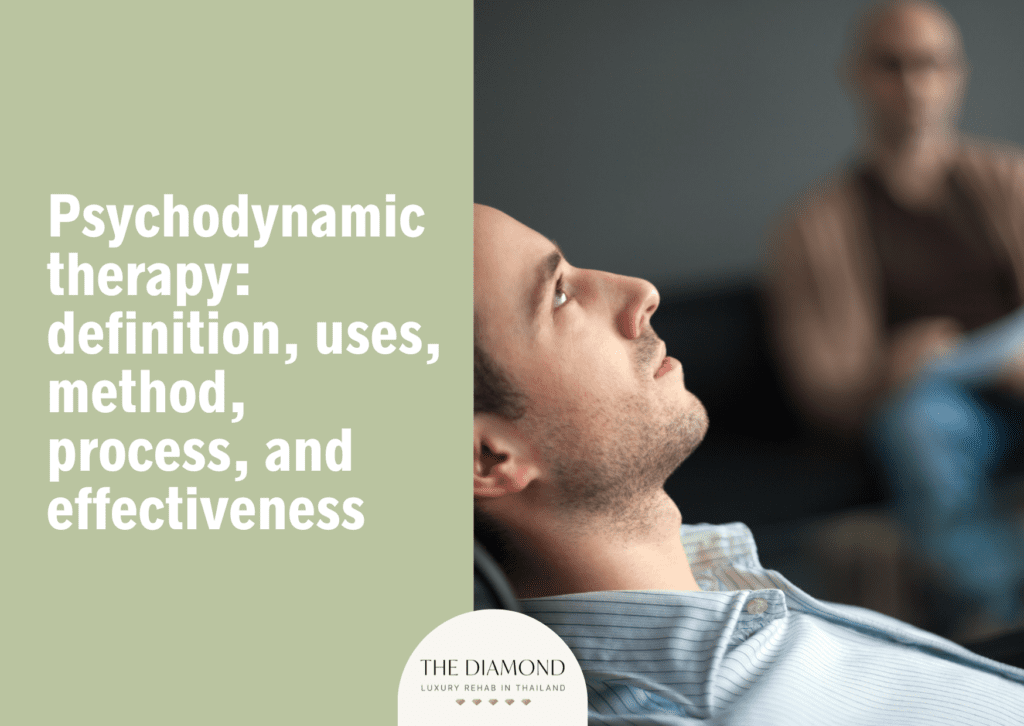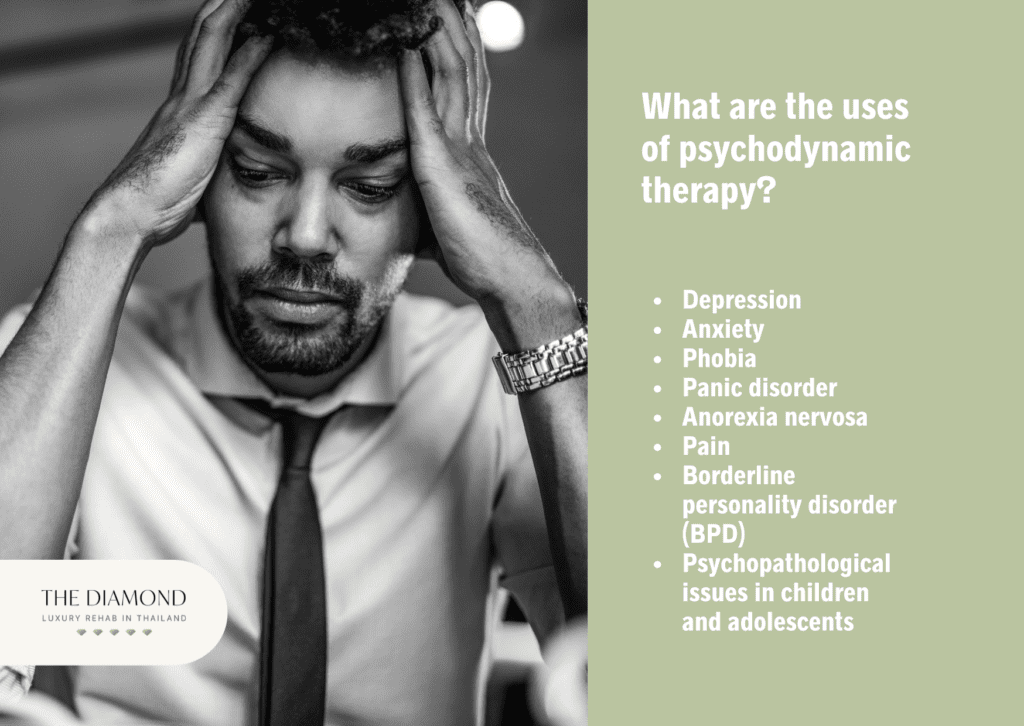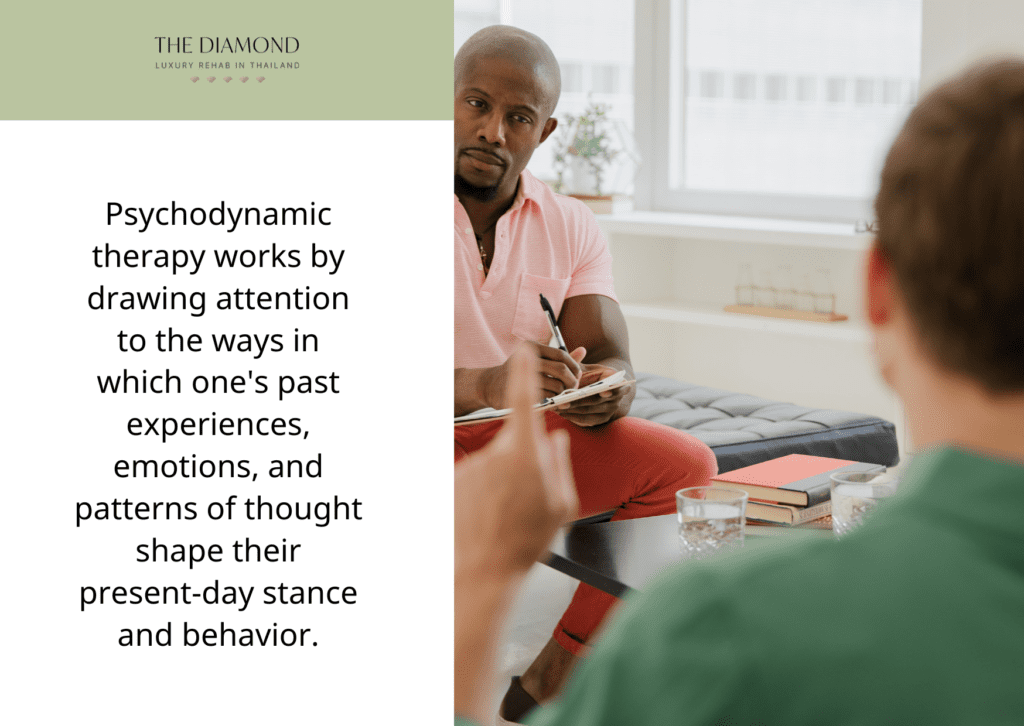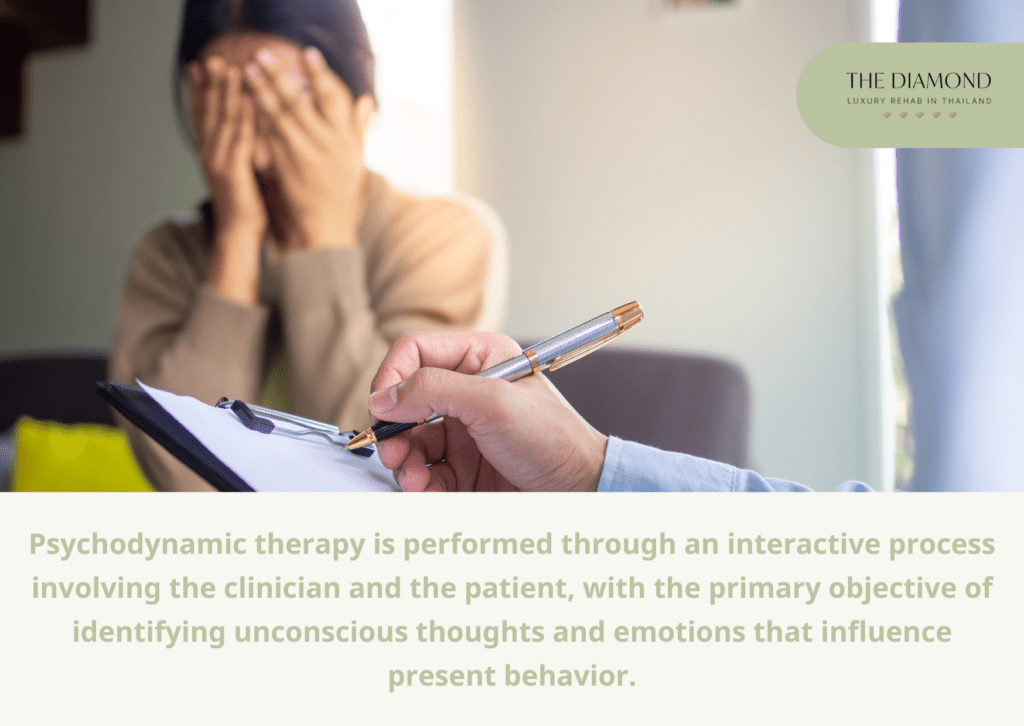Psychodynamic therapy: definition, uses, method, process, and effectiveness

Psychodynamic therapy—a type of talk therapy—focuses on investigating unconscious ideas, feelings, and past events in order to grasp emotional problems and behavior patterns. Meaningful conversation is used to identify deep-seated problems and promote self-awareness along with mental growth.
The uses of psychodynamic therapy are for conditions such as depression, anxiety, phobia, panic disorder, anorexia nervosa, pain, borderline personality disorder, and psychopathological issues in children and adolescents.
The method of psychodynamic therapy entails looking at how one’s emotions, thoughts, and experiences from the past impact their present-day actions and feelings. People are encouraged to reflect on their past and delve into their inner experiences once a safe therapeutic relationship has been created.
The process of psychodynamic therapy entails the therapist and client working together to identify unconscious feelings and ideas influencing the client’s behavior at the moment. As a way for the therapist to spot trends, themes, and underlying issues, sessions provide a secure space for people to freely express their emotions and experiences.
Psychodynamic therapy has been demonstrated to be effective, with evidence that it helps kids and teens with mental health problems like anxiety and depression. With clearly improved emotional and behavioral functioning, research additionally points out the therapy’s value for physical problems, eating disorders, depression, and certain anxiety disorders.
What is psychodynamic therapy?
Psychodynamic therapy is a form of psychological treatment inspired in the ideas of psychoanalysis, stressing the investigation of unconscious processes impacting ideas, emotions, and behaviors. This method looks for ingrained conflicts and patterns usually starting in early life events.
Unlike other therapies mainly focusing on symptom management, PDT seeks to address root causes. The therapeutic relationship in PDT is a fundamental component of the therapy since it gives people a place free from judgment to examine emotions and ideas.
PDT looks at interactions in all kinds of settings, including therapy sessions. Transference—the therapist-client relationship—showcases how clients interact with others and provide a forum for transformation.
Is psychodynamic therapy a pseudoscience or real psychology?
Psychodynamic therapy is real psychology, as it is grounded in well-established theories and has empirical support for its effectiveness in treating various mental health conditions. Based on Sigmund Freud’s theories and later improved by others, PDT emphasizes how early experiences, emotional conflicts, and unconscious processes shape an individual’s behavior and mental health.
Based on Sigmund Freud’s theories and later improved by others, PDT emphasizes how early experiences, emotional conflicts, and unconscious processes shape an individual’s behavior and mental health.
While it has faced criticism in the past for its subjective methods and reliance on interpretative techniques, modern psychodynamic therapy is grounded in research. For instance, a 2023 report by Leichsenring et al., titled, “The status of psychodynamic psychotherapy as an empirically supported treatment for common mental disorders – an umbrella review based on updated criteria” asserted that robust evidence endorses PDT for depressive and somatic symptom disorders, whilst intermediate evidence advocates its application in anxiety and personality disorders.
PDT had clinically significant effect sizes that surpassed those of control conditions, including both inactive controls and active treatments such as pharmacotherapy and cognitive behavioral therapy (CBT).
What are the uses of psychodynamic therapy?

Psychodynamic therapy is used for the management of various emotional and psychological problems and conditions. The most common uses of psychodynamic therapy are listed below.
- Depression: Psychodynamic therapy looks at unconscious tendencies and unresolved issues leading to depression. Addressing regret, grief, and self-criticism stemming from prior events helps people become more self-aware and create better coping strategies. Studies have demonstrated that short-term psychodynamic psychotherapy (STPP) significantly improves general psychopathology, anxiety, and depression, as per a 2021 report from the Australian & New Zealand Journal of Psychiatry titled, “Psychodynamic therapy of depression.” LTPP, or long-term psychodynamic therapy, is additionally beneficial for other complex depressive disorders.
- Anxiety: Anxiety often stems from suppressed fears or unresolved emotional conflicts. Psychodynamic therapy uncovers and works through the underlying causes, helping individuals understand triggers and reduce anxious thoughts and behaviors.
- Phobia: A phobia is often linked to unconscious fears or past traumas. PDT identifies and addresses these hidden connections, reducing avoidance behaviors and improving emotional responses to the feared object or situation.
- Panic disorder: Panic disorder is often linked to deep-seated emotional disturbances or unconscious anxiety. Psychodynamic therapy helps individuals explore the roots of their fear, uncovering past trauma or unresolved stressors that trigger episodes. Effective in lowering symptoms of panic disorder, panic-oriented psychodynamic psychotherapy (PFPP) is an organized, manualized psychodynamic therapy, according to a 2012 paper by Sandberg et al., titled, “Panic-Focused Psychodynamic Psychotherapy in a Woman with Panic Disorder and Generalized Anxiety Disorder.” The treatment is mostly concerned in spotting and resolving unconscious emotional problems that fuel panic attacks. PFPP investigates how early events—such as trauma or repressed anger—shape the onset of panic attacks.
- Anorexia nervosa: Anorexia nervosa frequently entails challenges with emotional expression, control, and self-worth. Psychodynamic therapy aims to reveal fundamental psychological difficulties, such as lingering familial issues or trauma, that lead to distorted body image and restrictive eating practices. Working through these challenges, people are able to better comprehend the feelings influencing their actions. More adaptive coping mechanisms are encouraged through the therapy’s support of healthy connections with food and self-image.
- Pain: Chronic pain often intertwines with emotional factors like repressed feelings or unresolved trauma. Connecting the mind and body, psychodynamic therapy looks for psychological causes of physical pain. Knowing these emotional components releases relief and lessens the intensity of pain.
- Borderline personality disorder (BPD): Emotional instability and interpersonal conflicts define borderline personality disorder. According to a 2018 article by Miguel Angel Gonzales-Torres titled, “Psychodynamic psychotherapies for borderline personality disorders. Current developments and challenges ahead,” research has demonstrated that two evidence-based psychodynamic therapies are beneficial in treating BPD: mentalization-based treatment (MBT) and transference-focused psychotherapy (TFP). MBT improves the patient’s mentalization skills, which lessen impulsivity and help control emotions, particularly in social situations. TFP seeks to integrate identity and enhance affect control, self-coherence, and reflection.
- Psychopathological issues in children and adolescents: Psychological struggles in children and adolescents often stem from developmental challenges or early life difficulties. Through psychodynamic therapy, young people uncover repressed emotions and express them in a safe setting. Being aware of these feelings promotes emotional development and better habits. The emotional foundation of the individual is fortified and their mental development is facilitated by the resolution of underlying issues.
How is the psychodynamic approach used today?
The psychodynamic approach is used today in various therapeutic contexts to help individuals explore the underlying causes of their emotional and psychological challenges. Finding unconscious feelings and ideas that impact current relationships and behavior—often derived from prior experiences—is PDT’s main goal.
Modern adaptations stress short, regimented sessions, which makes them more pragmatic and easily available than classic psychoanalysis. In order to give all-encompassing care, integrative therapies build on this approach and combine it with others, such as cognitive behavioral therapy. Through fostering self-awareness and emotional insight, the psychodynamic approach continues to play a significant role in contemporary mental health treatment.
How does psychodynamic therapy work (method)?

Psychodynamic therapy works by drawing attention to the ways in which one’s past experiences, emotions, and patterns of thought shape their present-day stance and behavior. Part of the process is building a strong therapeutic relationship whereby the patient feels secure to look at their inner experiences.
The therapist encourages the patient to reflect on their history, identifying patterns, unresolved conflicts, and traumatic experiences (especially ones from childhood) possibly impacting their present difficulties.
Techniques such as free association, where people share thoughts without filtering, and the analysis of transference, where feelings about important past relationships are projected onto the therapist, are central to the process. The therapist additionally identifies defense mechanisms, such as denial or repression, that patients use to avoid painful feelings.
How many sessions are required for psychodynamic therapy?
Psychodynamic therapy typically requires a range of 24 to over 50 sessions, depending on the therapy’s scope and the patient’s needs. Brief psychodynamic therapy (BPT) typically involves fewer than 24 sessions, aiming to provide focused and time-efficient treatment, according to a 2022 paper by Jessica Porcelan and Katherine Scribner titled, “Brief Psychodynamic Psychotherapy: A Review and Illustrative Case Vignette.”
The study further stated that BPT is a structured therapeutic approach that condenses the timeframe of traditional psychodynamic therapy, reducing the duration from years to months. It is designed to achieve specific, limited goals such as improving coping skills and providing insight into a few key disabling symptoms.
In contrast, long-term psychodynamic therapy potentially extends to 50 sessions or more, often spanning several years, to address deeper, more complex psychological issues. According to the seventh chapter of the publication titled, “Treatment Improvement Protocols Series, No. 34: Brief Interventions and Brief Therapies for Substance Abuse” last revised by the Substance Abuse and Mental Health Services Administration in 2012, the healing and transformation process that long-term psychodynamic treatment envisions usually takes at least two years of sessions.
Therapy typically aims to modify a client’s identity or personality or integrate essential developmental skills lost while the individual was stuck at an earlier emotional growth stage.
When is psychodynamic therapy finished?
Psychodynamic therapy is considered finished when the individual has achieved significant emotional insight, resolved key conflicts, and developed healthier coping mechanisms for their life challenges.
The conclusion of therapy depends on whether the person feels equipped to manage relationships, emotions, and stressors independently. Progress is often measured through the reduction of symptoms, improved interpersonal functioning, and a stronger sense of self-awareness.
The decision to end therapy is typically made collaboratively between the therapist and the individual, ensuring the person feels confident in their ability to maintain the changes achieved. While some choose to revisit therapy in the future for additional support, the primary goal is for lasting emotional growth and resilience.
How is psychodynamic therapy performed (process)?

Psychodynamic therapy is performed through an interactive process involving the clinician and the patient, with the primary objective of identifying unconscious thoughts and emotions that influence present behavior.
In a normal session, the therapist establishes a secure and encouraging space for the client to freely express their feelings, ideas, and experiences. The therapist often begins the session by actively listening to the person in therapy as they share their thoughts, observing patterns, themes, and unconscious processes.
Techniques such as free association, where clients speak freely without censorship, are used to uncover hidden conflicts. For the purpose of understanding how the person’s current relationships and emotional states are impacted by past experiences, particularly those from childhood, the therapist investigates these experiences.
Interventions such as interpretation to bring unconscious information into conscious awareness, clarification to help the patient better understand their feelings, and empathic validation to validate their feelings are all used by the therapist during the session. Transference, where the individual projects feelings about important figures onto the therapist, is often explored as a way to understand relational dynamics.
In addition to talking about defense strategies like denial or repression, sessions help the individual face and deal with such behaviors. Better emotional control, self-awareness, and healthier relationships result from the patient’s gradual understanding of their unconscious tendencies.
What does a psychodynamic therapist do?
A psychodynamic therapist works with people in comprehending the subliminal contributors to their emotions, thoughts, and behaviors. They make patients feel comfortable enough to open up about everything on their minds.
Through actively and attentively listening, the therapist spots recurring patterns, coping strategies, and unresolved issues resulting from earlier experiences, particularly in early relationships.
In order to promote introspection and help the patient make connections between their past and present experiences, a psychodynamic therapist frequently poses open-ended questions. They additionally encourage a curious attitude, helping patients to see how their internal world impacts their perspective of others and themselves.
People who struggle to define their emotions develop a wider emotional vocabulary and a better awareness of their own triggers with the assistance of therapists. As patients acquire understanding, PDT practitioners monitor their progress and modify the therapy focus to keep sessions pertinent to their changing objectives.
At the end of the day, therapists are just like guides; they assist those they treat in working through complicated emotions while gaining a more complete understanding of who they are.
Is psychodynamic therapy effective?
Yes, psychodynamic therapy is effective. Findings of a 2019 study by Gatta et al., titled, “Effectiveness of Brief Psychodynamic Therapy With Children and Adolescents: An Outcome Study” demonstrated that brief psychodynamic therapy (BPT) is beneficial in lowering psychological symptoms in kids and teenagers, especially when it comes to internalizing issues like depression and anxiety.
Validated measures such as the Youth Self Report (YSR) and the Child Behavior Checklist (CBCL) showed notable gains in emotional and behavioral functioning over a 12-month period. A 2015 article titled, “The effectiveness of psychodynamic psychotherapies: an update” by Peter Fonagy indicated that psychodynamic therapy (PDT) is useful for somatic issues, eating disorders, depression, and certain anxiety disorders.
Long-term PDT has the strongest evidence for treating personality disorders, especially borderline personality disorder. PDT and medication together frequently produce better results, especially in cases of depression. Patients who received combination treatment had improved drug adherence and greater rates of recovery.
Why is psychodynamic therapy controversial?

Psychodynamic therapy is controversial for a number of reasons, primarily due to its historical roots, subjective nature, and mixed evidence for its effectiveness. The Freudian psychoanalysis-based therapy assumes that unconscious urges and early childhood experiences drive behavior and emotions.
This perspective, critics say, oversimplifies human experience by ignoring the significance of contextual elements including social, cultural, and environmental factors in determining psychological well-being.
The dependence of the therapy on subjective interpretation has led to questions regarding consistency in practice since various therapists usually implement its ideas in different ways. Moreover, the conventional long-term strategy of PDT is less accessible to various individuals since it is sometimes considered as expensive, time-consuming, and impractical.
A paper titled, “Psychodynamic therapies versus other psychological therapies for depression” published in the September 2014 issue of the Cochrane Database of Systematic Reviews revealed that according to critics, the inclusion of diverse demographics and a range of psychodynamic therapy techniques in earlier studies is frequently to blame for discrepancies in PDT’s research findings.
Skepticism regarding psychodynamic therapy’s suitability for clinical practice additionally stems from the notion that it lacks the systematic, manualized approach of more modern therapies like cognitive behavioral therapy (CBT).
The study recognized the continued widespread usage and value of psychodynamic treatment in practice in spite of these criticisms. It brought to light a notable discrepancy between the literature’s inconsistent empirical support and its therapeutic popularity.


